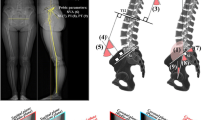Abstract
Nowadays, conventional or digitalized teleradiography remains the most commonly used tool for the study of the sagittal balance, sometimes with secondary digitalization. The irradiation given by this technique is important and the photographic results are often poor. Some radiographic tables allow the realization of digitalized spinal radiographs by simultaneous translation of X-ray tube and receptor. EOS system is a new, very low dose system which gives good quality images, permits a simultaneous acquisition of upright frontal and sagittal views, is able to cover in the same time the spine and the lower limbs and study the axial plane on 3D envelope reconstructions. In the future, this low dose system should take a great place in the study of the pelvispinal balance. On the lateral view, several pelvic (incidence, pelvic tilt, sacral slope) and spinal (lumbar lordosis, thoracic kyphosis, Th9 sagittal offset, C7 plumb line) parameters are drawn to define the pelvispinal balance. All are interdependent. Pelvic incidence is an individual anatomic characteristic that corresponds to the “thickness” of the pelvis and governs the spinal balance. Pelvis and spine, in a harmonious whole, can be compared to an accordion, more or less compressed or stretched.











Similar content being viewed by others
References
Legaye J, Saunier P, Dumas R, Vallee C (2009) Correction for patients sway in radiographic biplanar imaging for three-dimensional reconstruction of the spine: in vitro study of a new method. Acta Radiol 50(7):781–790
Vialle R, Levassor N, Rillardon L, Templier A, Skalli W, Guigui P (2005) Radiographic analysis of the sagittal alignment and balance of the spine in asymptomatic subjects. J Bone Joint Surg Am 87-A:260–267
Roussouly P, Gollogly S, Berthonnaud E, Dimnet J (2005) Classification of the normal variation in the sagittal alignment of the human lumbar spine and pelvis in the standing position. Spine 30:346–353
Rajnics P, Pomero V, Templier A, Lavaste F, Illes T (2001) Computer-assisted assessment of spinal sagittal plane radiographs. J Spinal Disord 14:135–142
Dubousset J, Charpak G, Dorion I et al (2005) A new 2D and 3D imaging approach to musculoskeletal physiology and pathology with low-dose radiation and the standing position: the EOS system. Bull Acad Natl Med 189(2):287–297
Dubousset J, Charpak G, Skalli W, Kalifa G, Lazennec JY (2007) EOS stereo-radiography system: whole-body simultaneous anteroposterior and lateral radiographs with very low radiation dose. Rev Chir Orthop Reparatrice Appar Mot 93:141–143
Deschênes S, Charron G, Beaudoin G, Labelle H, Dubois J, Miron MC, Parent S (2010) Diagnostic imaging of spinal deformities: reducing patients radiation dose with a new slot-scanning X-ray imager. Spine 35(9):989–994
Duval-Beaupère G, Schmidt C, Cosson P (1992) A barycentremetric study of the sagittal shape of spine and pelvis: the conditions required for an economic standing position. Ann Biomed Eng 20(4):451–462
Jackson RP, McManus AC (2004) Pelvic lordosis and pelvic incidence: the relationship of pelvic parameters to sagittal spinal profile. Curr Opin Orthop 15:150–153
Schwab F, Lafage V, Boyce R, Skalli W, Farcy JP (2006) Gravity line analysis in adult volunteers. Age-related correlation with spinal parameters, pelvic parameters and foot position. Spine 31:E959–E967
Putto E, Tallroth K (1990) Extension-flexion radiographies for motion studies of the lumbar spine a comparison of two methods. Spine 115:107–110
Farfan HJ (1973) Mechanical disorders of the low back. Lea and Febiger, Philadelphia
Morgan FP, Kingt T (1957) Primary instability of lumbar vertebra as common cause of low back pain. J Bone Joint Surg Br 39:6–22
Froning EC, Frohman B (1968) Motion of the lumbosacral spine after laminectomy and spine fusion. Correlation of motion with the result. J Bone Joint Surg Am 50(5):897–917
Conflict of interest
None of the authors has any potential conflict of interest.
Author information
Authors and Affiliations
Corresponding author
Rights and permissions
About this article
Cite this article
Morvan, G., Mathieu, P., Vuillemin, V. et al. Standardized way for imaging of the sagittal spinal balance. Eur Spine J 20 (Suppl 5), 602 (2011). https://doi.org/10.1007/s00586-011-1927-y
Received:
Accepted:
Published:
DOI: https://doi.org/10.1007/s00586-011-1927-y




